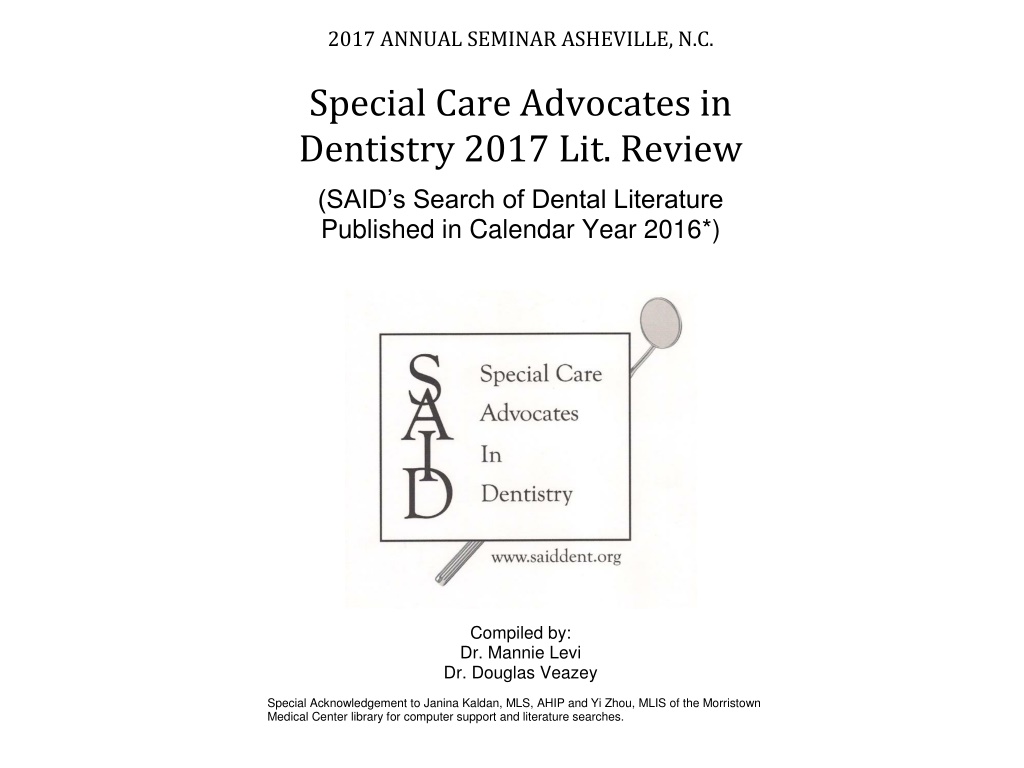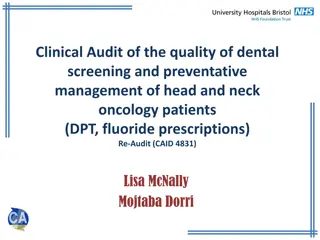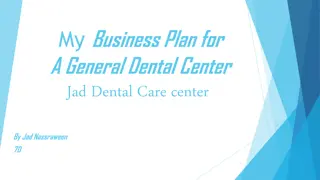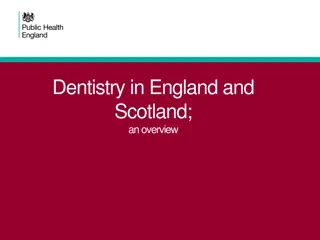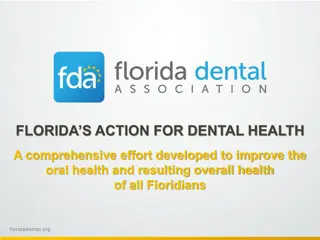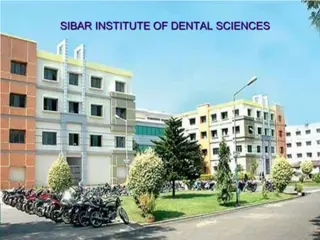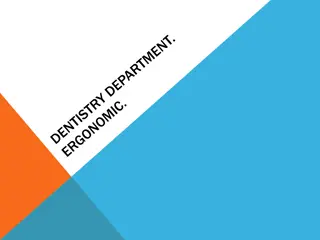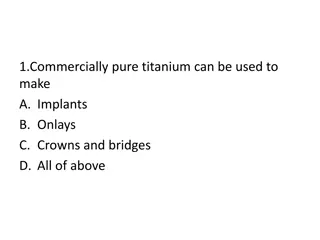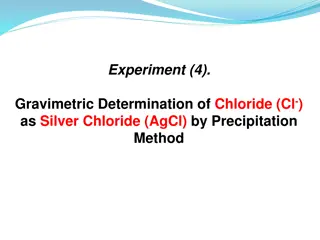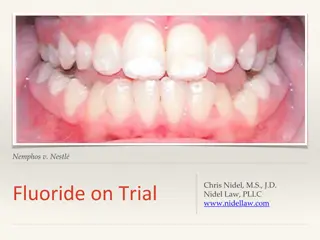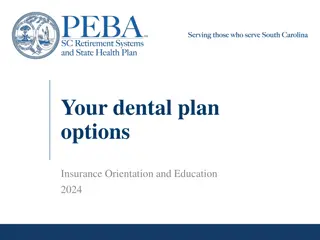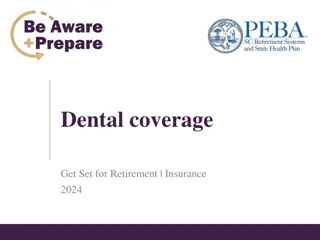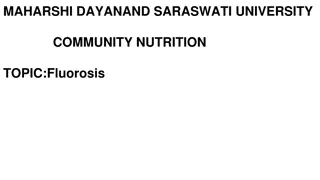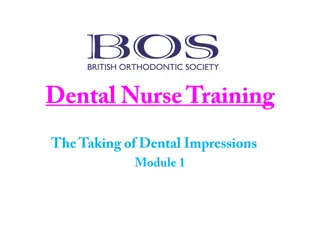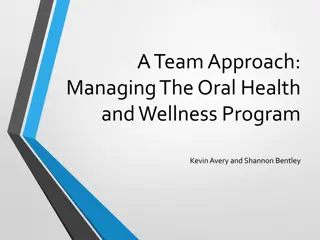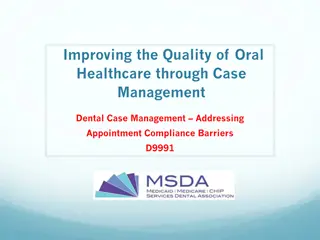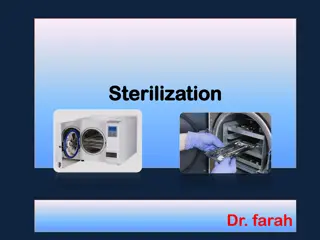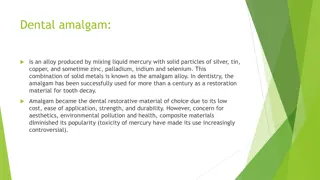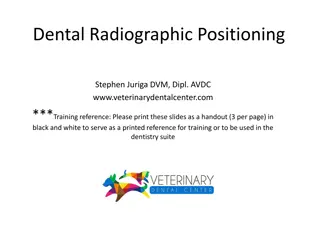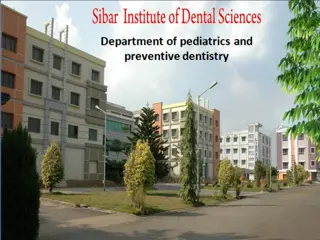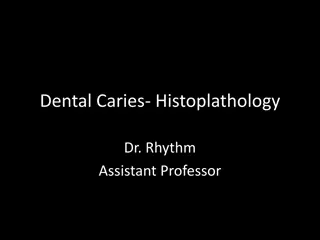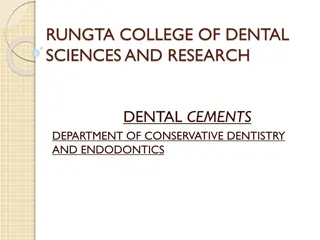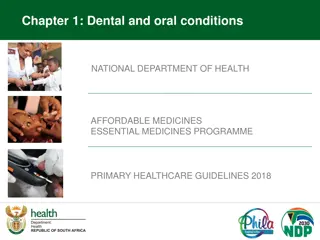Silver Diamine Fluoride in Dental Care: A Literature Review
This literature review delves into recent journal articles related to oral health care for individuals with mental and physical disabilities, focusing on the clinical use of Silver Diamine Fluoride. The review highlights its efficacy in managing caries in children, root caries in the elderly, desensitizing teeth, and caries control, emphasizing the silver and fluoride ions' collaborative benefits in promoting remineralization.
Download Presentation

Please find below an Image/Link to download the presentation.
The content on the website is provided AS IS for your information and personal use only. It may not be sold, licensed, or shared on other websites without obtaining consent from the author. Download presentation by click this link. If you encounter any issues during the download, it is possible that the publisher has removed the file from their server.
E N D
Presentation Transcript
2017 ANNUAL SEMINAR ASHEVILLE, N.C. Special Care Advocates in Dentistry 2017 Lit. Review (SAID s Search of Dental Literature Published in Calendar Year 2016*) Compiled by: Dr. Mannie Levi Dr. Douglas Veazey Special Acknowledgement to Janina Kaldan, MLS, AHIP andYi Zhou, MLIS of the Morristown Medical Center library for computer support and literature searches.
Recent journal articles related to oral health care for people with mental and physical disabilities. Search Program = PubMed Database = Medline Journal Subset = Dental Publication Timeframe = Calendar Year 2016* Language = English SAID Search-Term Results = 1981 Initial Selection Result = 456 articles Final Selection Result =128 articles SAID Search-Terms Employed: Intellectual disability Mental retardation Mental deficiency Mental disorders Mental health Mental illness Dental care for disabled Dental care for chronically ill Special Needs Dentistry Disabled Behavior management Behavior modification Behavior therapy Cognitive therapy Down syndrome Cerebral palsy Epilepsy Enteral nutrition Physical restraint Immobilization 1. 2. 3. 4. 5. 6. 7. 8. 9. 10. 11. 12. 13. 14. 15. 16. 17. 18. 19. 20. 21. Protective devices 22. Moderate sedation 23. Conscious sedation 24. Analgesia 25. Anesthesia 26. Dental anxiety 27. Nitrous oxide 28. Gingival hyperplasia 29. Gingival hypertrophy 30. Autism 31. Silver Diamine Fluoride 32. Bruxism 33. Deglutition disorders 34. Community dentistry 35. Access to Dental Care 36. Gagging 37. Substance abuse 38. Syndromes 39. Tooth brushing 40. Pharmaceutical preparations
Clinical Use of Silver Diamine Fluoride In Dental Treatment May L. Bei,BDS,MDS,PHD; Edward Chin-Man Lo BDS,MDS,PHD, Chun- Hung Chu, BDS,MDS,PHD
Silver Diamine Fluoride Colorless Alkaline Fluoride Ions Silver Ions 38% Solution
Uses Managing Caries in Children Managing Root Caries in the Elderly Desensitizing Teeth Caries control/Off Label Use
Ammonia and Silver combine to form the Diamine-Silver Ion More Stable than Silver Fluoride Silver Ions are Bacteriocidal Fluoride Ions promote remineralization
Development of a squamous layer on the exposed dentin, plugging the dentinal tubules. (Hydrodynamic theory of dentin hypersensitivity). Increase resistance to acid dissolution and enzymatic digestion by bacterial proteases. Inhibits the proteins; matrix metalloproteinase, cathepsins and bacterial collagenases. Act against bacteria in lesion by breaking membranes, denaturing proteins and inhibiting DNA replication. Zombie Effect when bacteria killed by silver ions are added to living bacteria, the silver is re-activated so that effectively the dead bacterial kill the living bacteria. Increases in mineral density and hardness by formation of hydroxyapatite and fluorapatite along with presence of silver chloride and metallic silver.
Low Cost Easy to Use Black Stain Metallic Taste Gingival and Mucosal Irritation May cause Fluorosis in Large Doses
Does not stain sound enamel Many studies show no need for caries removal
Plastic-lined cover for counter, plastic-lined bib for patient Standard PPE for provider and patient One drop of SDF into the deep end of a plastic dappen dish Remove bulk saliva with saliva ejector Isolate tongue and cheek from affected teeth with gauze or cotton rolls Apply petroleum jelly with cotton applicator around lip and gingiva Dry affected tooth surfaces with triple syringe or dry with cotton Bend microbrush, immerse into SDF, remove excess on side of dappen dish Apply directly onto the affected tooth surfaces with microbrush Allow SDF to absorb for up to 1minute if reasonable, then remove excess with gauze or cotton roll. Rinse with water Place gloves, cotton and microbrushes into plastic waste bags
No consensus on frequency of application Once a week for three weeks (this study) for caries control Effective after 1 application for desensitivity
Managing Patients Using Novel Oral Anticoagulants(NOAs) in Dentistry; A Discussion Paper on Clinical Implications Constantinides, Rizzo,Pascalzo,Maglione
Purpose To discuss how to approach patients on NOAs before, during and after treatment
NOAs Pradxa (Dabigatran Etexilate) Xarelto (Rivaroxaban) Eliquis (Apixaban)
Advantages Antagonists at very specific steps of coagulation Provide stable anticoagulation at a fixed dose No need to monitor with lab exams
Advantages No INR Rapid Onset Rapidly reach peak concentration Wide therapeutic margin Low drug to drug interactions No significant food interactions
Methods Reviewed Literature through 2012
Pradaxa Direct Thrombin Inhibitor Binds to Thrombin and prevents Fibrinogen/Fibrin
Re-Ly 18,113 Patients Lower rates of stroke and embolism than Warfarin No Monitoring Has a reversal agent (Idarucizumab)
Dental Considerations DTI similar to Warfarin with INR of 2-3 Vitamin K antagonists with INR less than 3 No direct interaction with NSAIDs
Modification of Tx Renal Function Complexity and length of Procedure Patient Dependent Factors (age, aspirin)
Xarelto Factor Xa Inhibitor Indicated for Use in Hip and Knee Rplacement Surgery Prevention of Cerebrovascular complications in non-valvular A-Fib DVT
Rocket- AF Study 14,236 patients Significant decrease in stroke and embolism compared to Warfarin
Dental Considerations No need to discontinue for simple extractions in patients with normal Renal function No need to discontinue for routine procedures
Eliquis Factor Xa Inhibitor Same Indications as Xarelto
Aristotle Study 9260 Patients Peak Plasma Levels in 1-3 hours 12 Hour Life Excreted almost totally in Bile
Summary No need to discontinue for routine procedures Consider if over 5 extractions or surgery over 45 minutes
Articaine Buccal Infiltration Vs Lidocaine Inferior Block- A Review of the Literature G. Bartlett and J. Mansoor
Purpose Compare the effectiveness of Articaine buccal infiltrations and Lidocaine Blocks in mandibular Molars
Articaine Derived from thiphene not benzene More lipid soluble More potent, faster onset
Methods Literature Review 27 Studies
Methods Compared 4% Articaine Infiltration vs 2% Lidocaine IAN block Permanent teeth only Adults only Mandibular Molars only Success = pulpal anesthesia
Only 2 studies met these criteria Randomized double-blind studies
Results Success rate of 56-70% for Blocks Success rate of 65-70% for infiltrations
Conclusion No significant difference
Management of Patients with Cardiovascular Implantable Electronic Devices in Dental, Oral, and Maxillofacial Surgery James Tom, DDS
Review Article 3 Million patients with Pacemakers or Implantable Cardioverter Defibrillators 250,000 new patients annually Electromagnetic Interference
Current Recommendations Consultation with physician if within 30 days or if any change in medical history Consultation for any sedation/general anesthesia
Electrosurgery If using electrosugery, keep electrode dispersal pads as far away from CIED as possible and keep exposure times short
Minimal EMI from: Apex Locators Light Curing Units Handpieces Piezoelectric Dental Scalers Lasers
Very little EMI from Dental Imaging No effect from local anesthesia
